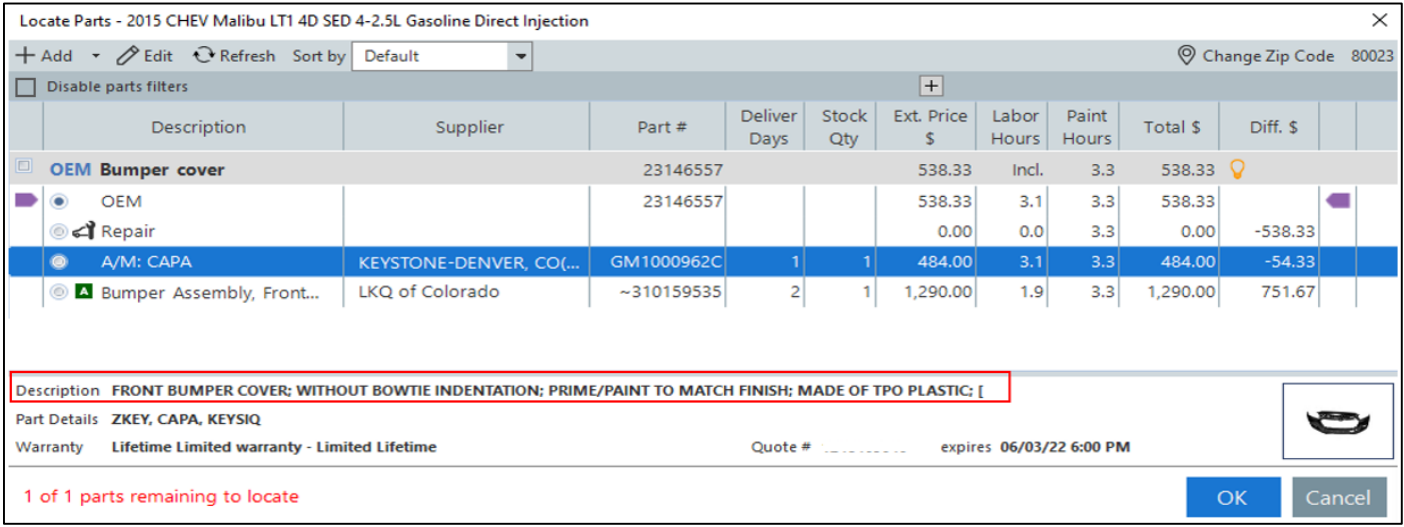
State Farm memo details significant change to non-OEM crash parts policy
By onInsurance | Repair Operations
A memo from State Farm to its Select Service® repair centers states that beginning Oct. 16, the carrier will end its yearslong suspension on the use of “non-OEM crash parts,” i.e. aftermarket parts.
“State Farm will sunset the current suspension of all non-OEM crash parts, when available and appropriate, for both policyholder and claimant estimates,” the carrier wrote.
The memo was provided to Repairer Driven News by a subscriber.
“In 1999, State Farm made a business decision to temporarily suspend the specification of non-Original Equipment Manufacturer (OEM) crash parts in vehicle repair estimates,” State Farm wrote in the memo. “Non-OEM crash parts are outer sheet metal and plastic parts such as headlamps, fenders, hoods, tail lamps, and bumper components manufactured by a company other than the manufacturer of the vehicle.
“State Farm recognizes certification standards developed by the Certified Automotive Parts Association (CAPA) and NSF International (NSF) for non-OEM crash parts. Non-OEM crash parts included on estimates prepared by State Farm or a Select Service® repairer will be certified by CAPA or NSF.”
State Farm went on to provide a list of non-OEM crash parts that are subject to certification standards:
-
- Bumper components;
- Lighting components;
- Radiator supports/tie bars/inner structural and associated mounting components; and
- Outer sheet metal, plastic/composite, and attachment parts.
The memo doesn’t say how State Farm will handle parts that are decertified after they’ve been put on vehicles. Users can register for weekly and/or monthly CAPA parts updates as well as decertified part reports online at https://e1.intertek.com/capa.
State Farm provides a promise that customers will be satisfied with the fit, corrosion resistance qualities, and performance of these parts for as long as they own their vehicle. If you confirm an issue with the fit or performance of these parts, you should notify CAPA of the issue using this link and replace the part appropriately.
Exterior parts including bumper covers, lighting, moulding, or outer sheet metal that has the OEM or vehicle name or logo on it cannot be replaced with aftermarket parts, according to State Farm’s memo.
“When locating non-OEM crash parts within CCC One, some suppliers may provide a description that indicates the component would not be eligible,” State Farm wrote. “The supplier’s description in the example below states, ‘Front Bumper Cover; Without Bowtie Indentation.’ Because this component has a manufacturer’s logo indented in the bumper cover, it would not be a candidate for non-OEM replacement.”
Repair centers that have agreed to State Farm’s Select Service Agreement must warranty the parts, write estimates that comply with applicable local law for the use of the parts, discuss the use of the parts with vehicle owners, and clearly identify that they aren’t OEM parts on estimates, according to the memo.
State Farm markets its Select Service Vehicle Repair Program repair centers as a time-saving decision for policyholders.
“You can choose any shop you like to repair your vehicle’s damage,” State Farm’s website states. “But if you go with a shop that’s in the State Farm® Select Service network, you could save time and effort.”
A video about the program says repair centers that have signed on to the agreement are “committed to providing quality repairs in a timely manner” with a guaranteed completion date:
“Provider is also responsible to comply with any and all regulatory requirements related to estimate and parts disclosure,” the memo states. “Refer to the State Farm Select Service Agreement for additional details.”
In December, State Farm reintroduced the use of non-OEM bumper covers, headlamps, and tail lamps (including brackets and housings) to its DRP members in every state but Hawaii, Ohio, and Wyoming. State Farm said at the time that the decision was made to address supply chain issues. Prior to the decision, it carried out an eight-week test program of aftermarket parts use in Texas and Oklahoma.
A class action lawsuit representing millions of current and former policyholders in Illinois was approved in 2016 against State Farm that alleged the carrier conspired to elect a judge that helped overturn a $1.05 billion decision concerning the use of non-OEM auto body parts policyholder vehicles.
The complaint was filed in 2012 and a $250 million settlement agreement was approved by the court in September 2018. State Farm denied the RICO violations and unjust enrichment allegations made in the suit.
Images
Featured image credit: JHVEPhoto/iStock
More information
UPDATED CAPA Tracker now sends part issue notifications through app

